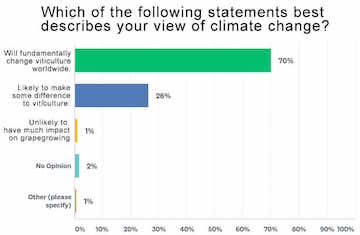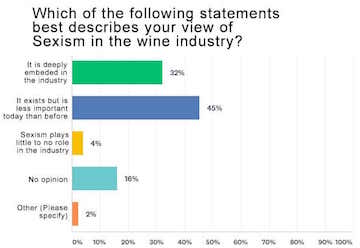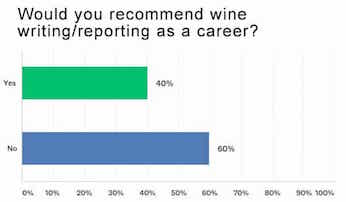How Wine Writers See the World—In Graph and Chart
I have since I first started to get to know them when I began working with them as a publicist back in the day. I didn’t know what to expect of them at first. But they turned out to often be very intelligent, curious, dedicated, interesting people. I was and am fascinated at how they dig so deep into what often seems like a banal subject. The best of them were writers and reporters first, with wine lover being a close second. It makes for a unique combination.
My recently released 2018 American Wine Writer Survey isn’t paean to the wine writer, however. It’s merely a reflection of my interest in how the American wine media works and thinks. When I conducted my first Wine Writer Survey in 1994 I wanted to know more about the people I so often worked with as I promoted and communicated on behalf of my clients in the wine industry. How these people work and think is still the purpose of the Wine Writer Survey.
Among the most interesting findings of the new survey is the way in which American wine writers think about various issues of concern to the wine industry: climate change, gender discrimination, natural wine.
On the issue of climate change, the overwhelming majority of respondents (70%) believe climate change will “Fundamentally change viticulture worldwide”. A mere 1% of survey-takers said it is “unlikely to have much impact on grapegrowing”. It will be the wine writing corps that chronicles any significant changes to the character of regional wines resulting from climate change. It appears they have their eyes wide open, ready to observe how this change to our environment will impact wine drinkers  and winemakers.
and winemakers.
The question of natural wine provokes a more diverse set of responses from wine writers. They were asked to choose from a series of statements in identifying their view of natural wine. The key takeaway is the difference in views of natural wine based on the age of the writer responding. The younger the writer, the more favorable their view of these wines and the more likely that they see them as important to the consumer. Older writers have a more jaundiced view of the category with 50% of those respondents 50 years of age or older saying Natural Wine will have little or no impact on consumers or that it is little more than a deceptive marketing tactic. On the other hand, no respondent 40 or under described Natural Wine as a deceptive marketing tactic.

Finally the survey uncovers that wine writers’ views on sexism in the wine industry are dependent upon their age and gender. The older they are the less likely a writer is to believe sexism is “deeply embedded in the wine industry”. Males are less likely to believe it is deeply embedded. Young female writers believe by a margin of 57% that sexism is “deeply embedded in the wine industry.” This is significant since younger wine writers skew significantly female. What does it mean? From the perspective of wine writing expect to see many more stories in the future of the question of gender equality in the wine industry.
 One question in the survey illuminates quite a bit: Would you recommend wine writing as a career? Only 40% of respondents said “yes”. Women, however, responded “yes” to the tune of 47%—nearly half. This is important because, again, the younger writers skew significantly female.
One question in the survey illuminates quite a bit: Would you recommend wine writing as a career? Only 40% of respondents said “yes”. Women, however, responded “yes” to the tune of 47%—nearly half. This is important because, again, the younger writers skew significantly female.
The very good and the very best wine writers in the United States sacrifice something for choosing wine writing. They toil in a career that does not pay well and that has become more of a struggle over the past two decades. Each of the very good and very best could probably easily take their demonstrable talents to another industry and created a better living for themselves. And yet here they are. While I sometimes question their decision making on this score, I love them for their decision to write about wine.


From the survey:
“What percent of your annual income is derived from wine-related writing/reporting?”
TAKEAWAYS
-No more than just over a quarter of wine writers earn 50% of their income from wine writing.
-Most writing about wine earn very little income doing so.
Quoting Wall Street Journal “On Wine” columnist Lettie Teague in her March 29, 2013 piece titled “Five Wine Blogs I Really Click With”:
“. . . [Allan Wright of the Zephyr Adventures tour operator, who has organized Wine Bloggers Conferences, said] Most of the bloggers were doing it just for ‘personal satisfaction’ . . . since the possibility of making money was quite small. Alder Yarrow, who writes a much-talked-about blog, Vinography, told me that he earns $12,000 to $16,000 from it annually, most of which comes from banner ads. . . .
“Most bloggers are more like Alice Feiring, a traditional wine journalist and blogger who has never made ‘a cent’ from her blog, the Feiring Line, which she started in 2004. (It’s one of the few that I read on a regular basis.) But unlike most other bloggers, Ms. Feiring has a newsletter; she has 450 subscribers paying $65 a year for 10 issues. ‘The blog was a soapbox; the newsletter is a mini-magazine,’ Ms. Feiring explained.”
URL: https://www.wsj.com/articles/SB10001424127887323419104578376630145206770?ns=prod/accounts-wsj
See next related comment . . .
Quoting Los Angeles Times “Daily Dish” columnist S. Irene Virbila in her March 20, 2013 piece titled “Wine Advocate Sues Ex-Critic Antonio Galloni for Missing Tasting Notes”
“First thought: $300,000 is an astonishingly high salary [for Antonio Galloni’s contributions to The Wine Advocate], especially since I remember seeing a tweet sent by someone at The Symposium for Professional Wine Writers at Meadowood Napa Valley in February.
“Only three of the wine writers in the room earned more than $25,000 per year from their writing.”
URL: http://articles.latimes.com/print/2013/mar/20/news/la-dd-wine-advocate-sues-excritic-antonio-galloni-for-missing-tasting-notes-20130320
Quoting The Wall Street Journal in their July 8, 2009 review of the book titled “Free: The Future of Radical Price” by Chris Anderson:
“It is easy to see why free is an appealing price for consumers, although how companies make money by giving stuff away is less obvious. In ‘Free: The Future of a Radical Price,’ Chris Anderson, the editor of Wired magazine and the author of ‘The Long Tail,’ sets out to explain why free is an increasingly compelling business model.
“Mr. Anderson explains how the underlying economics of digital services make free business models far more widespread than they were in the analog world. Central to the new ‘free economy’ he says, are the ‘near-zero “marginal costs” of digital distribution (that is, the additional cost of sending out another copy beyond the “fixed costs” of the required hardware).’ So Google spends billions on its software and infrastructure, to get its vast search engine up and running, but each incremental search costs it almost nothing.
“Free business models, whether purveying digital products or tangible goods, are based on cross subsidy. . . The free service is a loss leader (and cheap marketing) for premium paid services.
“Advertising is plainly the best known free model. . . . As Mr. Anderson notes, though, advertising can’t pay for everything online. If you have a blog, ‘no matter how popular,’ the revenue from AdSense — a Google service that places ads on Web sites — will probably never ‘pay you even minimum wage for the time you spend writing it.’
“Of course, that’s fine for bloggers more interested in fame or influence than in money or for blogs (like Mr. Anderson’s own) that are loss leaders for more lucrative endeavors, such as writing books or making speeches. But if you have to earn a living from the Web, ‘free’ can be a problem. . . .
URL: http://online.wsj.com/article/SB124701229573408977.html
Quoting The Wall Street Journal in their June 1, 2017 article titled “How Not to Expose Yourself on the Web” by (former) technology columnist Geoffrey A. Fowler:
“It starts with a golden rule: When the product is free, that means YOU are the product. YOUR privacy is the cost of a free social network, free tax prep or free photo storage.”
URL: https://www.wsj.com/articles/dont-expose-yourself-a-guide-to-online-privacy-1496249766?mg=prod/accounts-wsj
Quoting The Wall Street Journal in their November 15, 2018 article titled “Beware the ‘Free’ Internet” by economics columnist Greg Ip:
“Three weeks ago, Apple Inc. chief Tim Cook ripped into technology companies that ‘carefully assembled, synthesized, traded, and sold” then ‘weaponized’ their users’ data. ‘These stockpiles of personal data serve only to enrich the companies that collect them,’ he told a receptive audience in Brussels.
“If executives at his unnamed targets — Facebook Inc. and Google parent Alphabet Inc. — rolled their eyes, you can understand why. Mr. Cook is, after all, talking his book: Apple makes its money by charging premium prices for its products. Google and Facebook make theirs by giving away their products and then selling ads.
“Yet this is not just some internecine battle of billionaires. The zero-price business model is a source of many of the problems plaguing the Internet. It’s no coincidence that Google, Facebook and Twitter Inc. — which garner more than 80% of their revenue from advertising — are the ones most often accused of propagating toxic content and eroding privacy, while Microsoft Corp. and Apple, whose revenue comes from selling software, hardware and services, fly under the radar.
“Think about why price matters: It’s how the market rations precious resources. A price signals to suppliers how much to invest in a product. It’s how a consumer decides whether that product is the best use of her budget.
“A price of zero cripples that rationing role. When it comes to generating volume, free is a dream; when it comes to quality control, it’s a nightmare.
“Of course, ‘free’ comes in many forms online: Wikipedia is a labor of love. Many companies offer a free entry-level product in hopes of selling a premium version later.
“By contrast, ‘free’ is intrinsic to the profit model of search and social media: to generate ads they must maximize users and engagement, which results in the lowest possible barriers to their platforms. To target those ads, they must learn as much about their users as possible. This pits volume and revenue against quality and privacy.
. . .
“Of course, free services usually aren’t really free: users pay with their attention and data. . . .”
URL: https://www.wsj.com/articles/the-unintended-consequences-of-the-free-internet-1542210464
Thanks for sharing this. It was very illuminating to see! 🙂